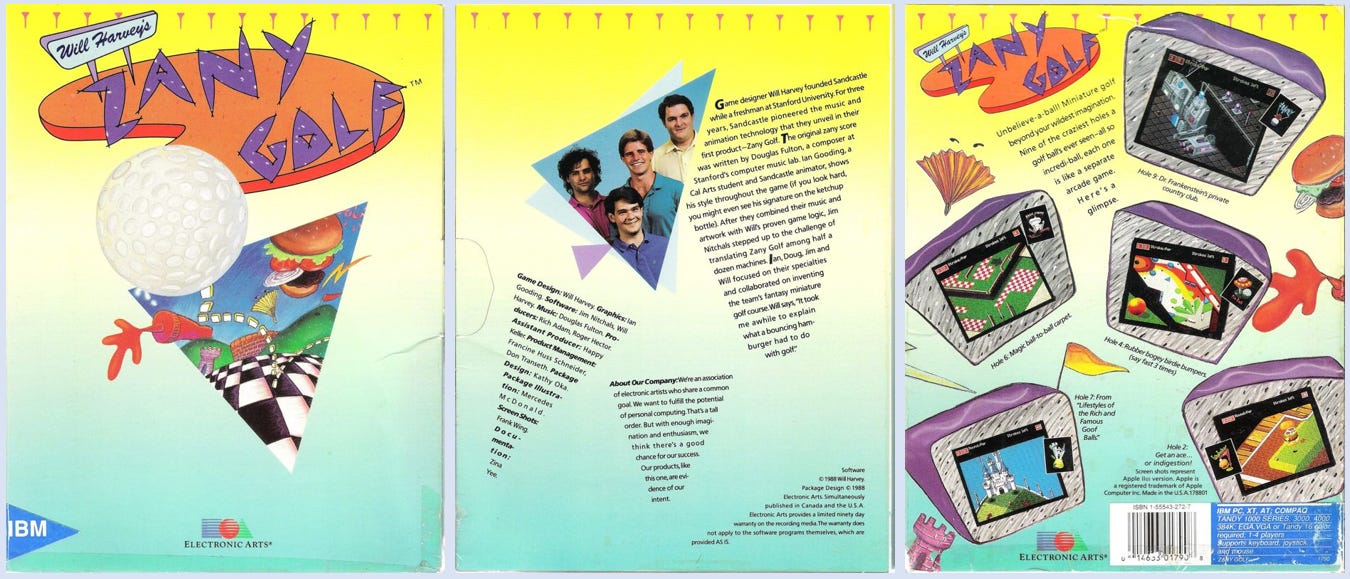The Classic PC Gaming Era (1977-1989) - Will Harvey’s Zany Golf
You should definitely play this brief but varied game of fantasy miniature golf with some fun surprises to uncover.

RELEASE DATE: 1988
DEVELOPER / PUBLISHER: Sandcastle / Electronic Arts
PLAYABILITY TODAY: Highly playable
BEST VERSIONS: Amiga, Atari ST, Apple IIGS
While there have been many golf games developed for the PC and other platforms, miniature golf, much like its real-life counterpart, has long been the less desirable digital sport and has often been the subject of shovelware. It’s hard to understand why, since miniature golf involves the same basic mechanics of billiards games but allows for much more imaginative environments and experiences. It’s also one of the few subgenres that lends itself naturally to the isometric diagonal perspective. And yet the category’s shining moment arrived in the late 1980s on the Amiga and Atari ST (with ports on the Apple IIGS, MS-DOS and, eventually, the Sega Genesis) in the form of Will Harvey’s Zany Golf, an amazing-looking isometric miniature golf game that’s played entirely with a mouse.

While Zany Golf only has nine holes (plus a bonus hole we’ll get to in a moment), it’s worth noting that most of those nine holes are amazingly crafted and involve more than just knocking a ball around a few wooden rails. Instead, most of these levels have some sort of puzzle element to them that involves using the mouse to manipulate the environment. On the second stage, a hamburger is blocking the hole, and you have to click the mouse button repeatedly to make the burger bounce so you can sink your putt. On a later hole, there are “magic carpet” tiles that allow you to control the ball with your mouse while it’s gliding across them. On yet another, the course is a functioning pinball machine and it’s up to you to sink your ball in a hole on the top left before it heads down the drain.
The game continues to up the ante from there. On a later level, the hole will be moving around and you’ll have to time a shot to get it in. Another time you’ll need to use fans to steer your ball around a lengthy course. The challenge is that you have a limited number of strokes, and even with the hints the game provides, it can be challenging to finish the game at all, let alone under par. But if you can finish under 26 strokes (or if you can time a shot into a secret passage on the 9th hole), you can access a very cool bonus hole called “Mystery” where you get to play a Breakout-style game with your ball and then get dumped on a checkerboard with some tiles that will teleport your ball around if it runs over them. It’s such a well-executed level it’s a shame to discover that it’s also the game’s last.
Zany Golf is one of those games that can be completed in a half an hour and which will leave you wanting much more, but it’s so well-designed and excellently executed that it’s a joy to replay. There’s a multiplayer mode for up to 4 players, and it was once an excellent showcase party game for the Apple IIGS’s improved graphics and capabilities. The carnival midway-style music and sound effects give the game a peculiar charm (particularly on the Apple IIGS, which has the best soundtrack by far), and the gorgeous graphics and clever usage of the isometric perspective create a wonderfully three-dimensional world that’s imaginatively decorated and smoothly animated.

The Atari ST and Amiga versions are also great but have scaled-down music due to the limitations of their sound chips. The DOS version looks good but sounds terrible; the biggest advantage of the DOS version is that it loads quite quickly on modern hardware. The Sega Genesis port, in the meantime, is the odd duck out because the controls don’t translate perfectly and the “Magic Carpet” level is removed as a result. But even on the Genesis, the game is a blast, and I was surprised to learn it’s regarded as one of the console’s lesser releases.
While Will Harvey’s name is in the title, the game’s box actually suggests that the entire team at Sandcastle provided pieces to make the whole. The artwork by Ian Gooding is an important aspect of setting up the level theming and translating some of the crazier ideas in the game into something that makes sense to the player, and Douglas Fulton’s soundtrack helps to set the tone. Jim Nitchals is also credited with porting the Apple IIGS original to different machines, and given how close the ports are, he clearly did an excellent job.
Sandcastle’s next (and last!) game was the polarizing 1990 release The Immortal, an isometric action RPG that plays like an ancient ancestor of Diablo. It’s not a bad game, but after the immense creativity seen in Zany Golf, it does feel like a step down. Even so, I’d recommend it on the Atari ST or Amiga; it’s a challenging game to start, but a rewarding one to finish.
As Our Series Continues…
In the coming weeks, we’ll talk about fighting games, gameroom games, puzzle games, unusual games and so much more.
And while you’ll definitely see some titles from prominent North American publishers like Sierra On-Line, Infocom, Activision, Electronic Arts, Brøderbund, SSI, MicroProse, Lucasfilm Games, Epyx and Sir-Tech in the mix, you’ll also see references to games from the United Kingdom, Australia, France, Spain and Japan.
If you’ve missed the earlier entries in the series, which cover ASCII games, adventure games, wargames, strategy games and role-playing games, you can find the entire archive at https://greatestgames.substack.com.
Anything I don’t share here will be in my upcoming book, tentatively titled The Greatest Games You (Probably) Never Played Vol. 1. Subscribe to this newsletter so you won’t miss it!



